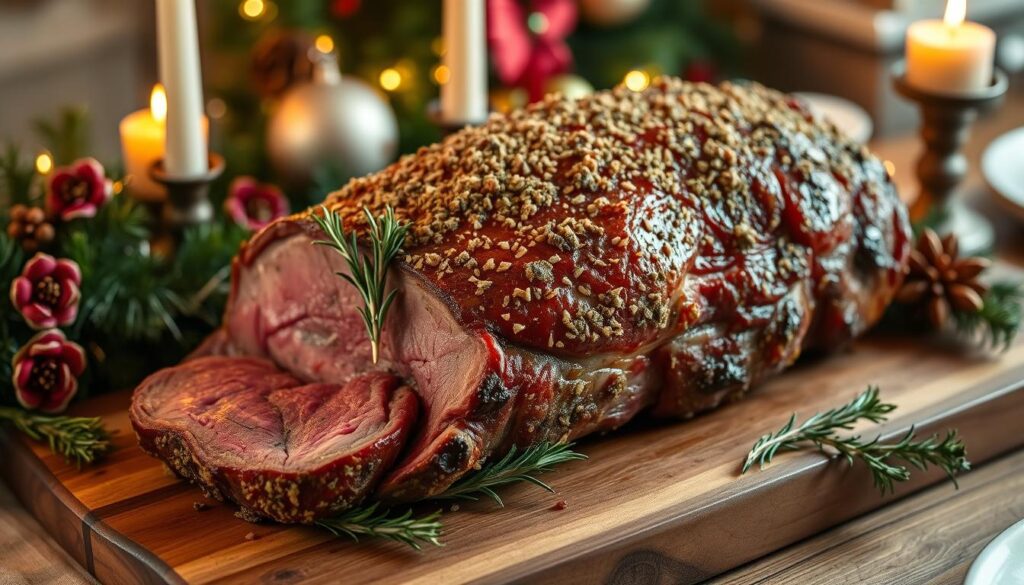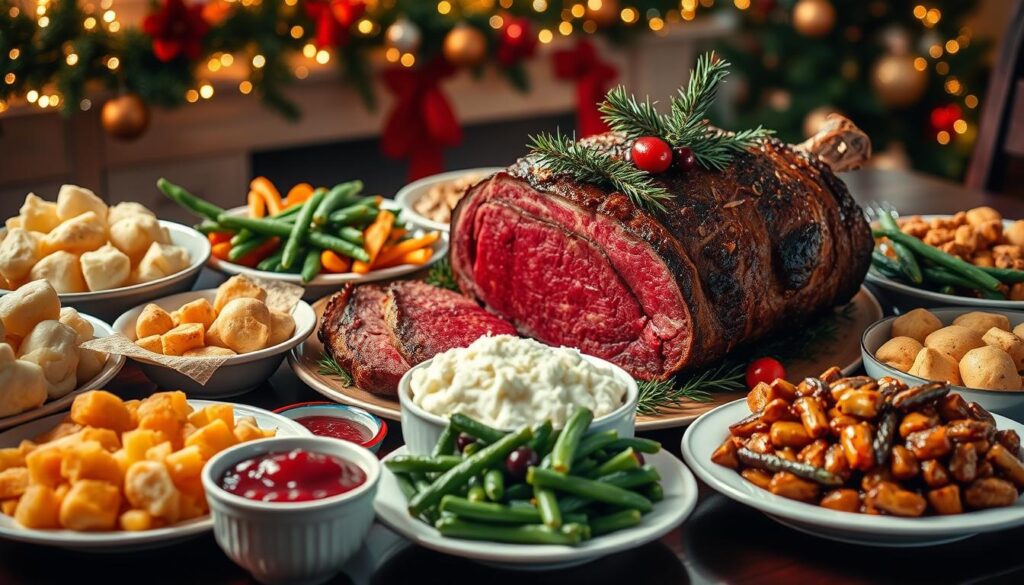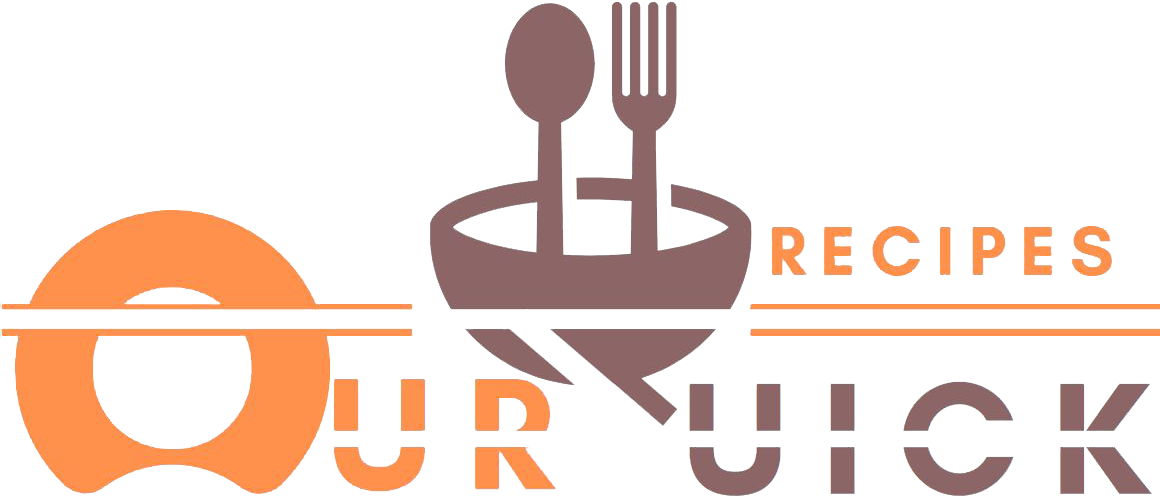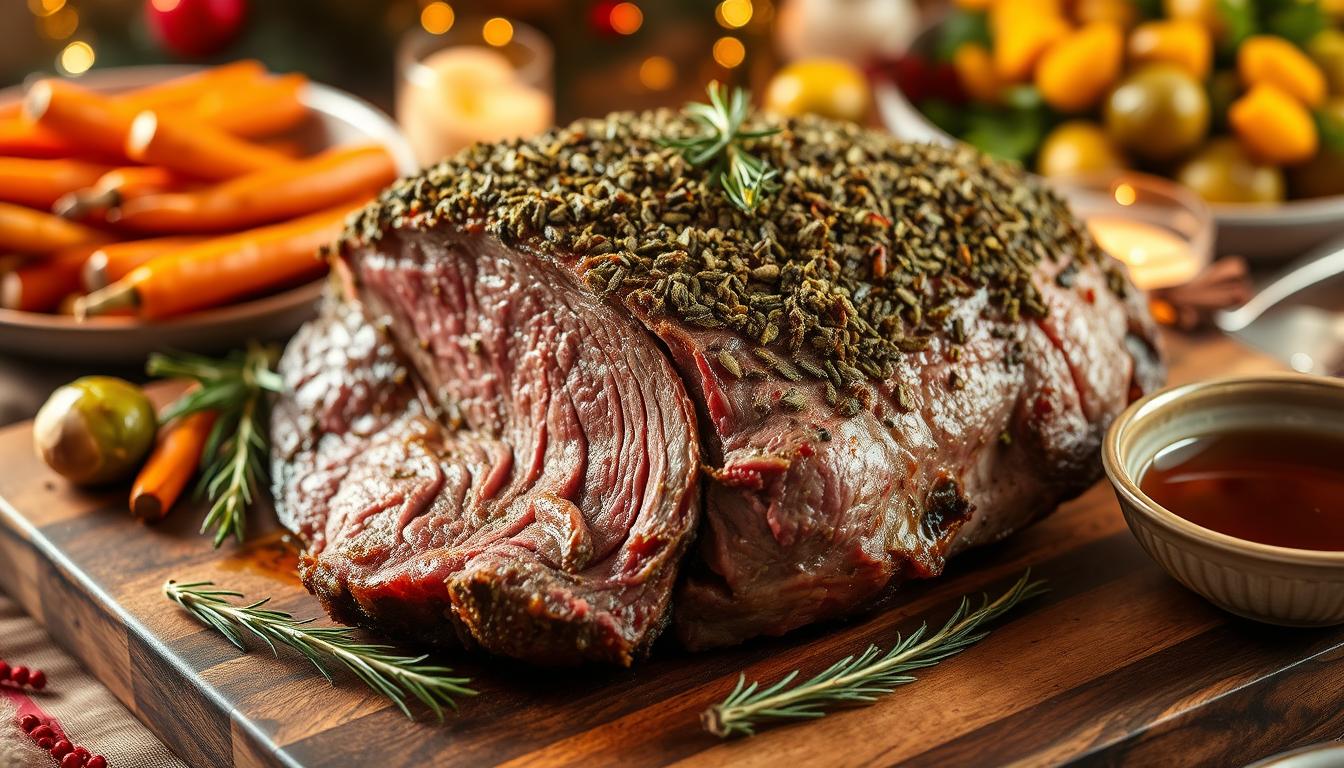As winter arrives, the air fills with the scent of evergreen. The holiday season is eagerly awaited. For many, Christmas dinner is the highlight, where family and friends come together. The prime rib roast is the star, with its tender, flavorful slices.
We’ll show you how to make an unforgettable herb-crusted prime rib roast. It will impress your guests and make them want to come back every year. We’ll guide you from choosing the right cut to perfecting the crust and roasting.
Key Takeaways
- Herb-crusted prime rib roast is a luxurious and impressive holiday main dish.
- The recipe involves creating a flavorful garlic-herb crust and perfecting the roasting technique.
- Prime rib is best served medium-rare to medium, with an internal temperature of 115-130°F.
- Proper prep and cooking time are crucial for a tender, juicy prime rib roast.
- Leftover prime rib can be stored and reheated for future meals.
Understanding Prime Rib: Your Ultimate Holiday Centerpiece
As the holidays near, the prime rib roast takes center stage. Known also as the standing rib roast, it’s a cut from the rib section of the cow. It’s the peak of luxury and sophistication. Whether you’re hosting a big party or a small gathering, a perfectly cooked prime rib can make your holiday dinner unforgettable.
What Makes Prime Rib Special
Prime rib stands out because of its unique flavor and texture. Its marbling, or the fat within the meat, makes it juicy and rich. This fat also boosts the meat’s taste. The tender and succulent nature of prime rib makes it a highlight of any holiday meal.
Grade Selection and Quality Factors
Choosing the right prime rib is key. The USDA grade matters a lot. USDA Prime has the most marbling and offers the best taste. But USDA Choice is also great and more budget-friendly. The fat cap on top should be about 1/4 inch thick for the best moisture and tenderness.
Size Guidelines per Guest Count
- A 4-5 lb bone-in prime rib roast (2-3 bones) can feed 4-6 people.
- A 7-8 lb bone-in roast (4-5 ribs) can serve 8-12 guests.
- As a general rule, plan for about 1 pound of prime rib per person for a bone-in roast, or 3/4 pound per person for a boneless roast.
“Prime rib epitomizes luxury and elegance, elevating any holiday feast to an unforgettable occasion.”
Essential Tools and Equipment for Perfect Roasting
To get a perfect prime rib roast, you need the right tools. You’ll need an oven-safe skillet and a probe thermometer. These items will help you make a delicious holiday dish.
A heavy-duty, oven-safe skillet or braiser is key for searing and roasting your prime rib. It can handle the oven’s high heat. This ensures your roast gets a crispy, even crust.
- A sharp, sturdy carving knife is essential for slicing the roast into elegant, uniform servings.
- A reliable probe thermometer is crucial for monitoring the internal temperature of the meat, ensuring it reaches the desired level of doneness.
- A large, durable cutting board provides a stable surface for carving and serving the prime rib.
With these tools, you’ll be ready to make a prime rib roast that will wow your holiday guests.
“Equipping your kitchen with the right tools is vital, especially when undertaking an elaborate recipe like a prime rib roast.”
Selecting and Preparing Your Herb-Crusted Prime Rib Roast
A perfectly cooked prime rib roast is the star of any holiday feast. To make your standing rib roast delicious, start with the right cut and preparation.
Choosing the Right Cut
Prime rib roasts usually weigh 4 to 5 pounds. You can choose bone-in or boneless. Plan for 1/2 to 1 pound per guest.
The beef’s grade matters too. Prime grade has more marbling, which means better flavor and tenderness.
Butcher’s Preparation Tips
- Ask your butcher to “french” the bones, trimming away excess fat and exposing the rib bones for a visually stunning presentation.
- Request that the butcher truss the roast, tying it securely to ensure even cooking throughout.
- Have the butcher remove any excess surface fat, leaving just a thin layer to baste the meat and create a crisp, flavorful crust.
Room Temperature Guidelines
Allow your prime rib roast to reach room temperature before you begin cooking. This ensures even cooking. Allow it to rest for approximately one hour before placing it in the oven.
“Proper preparation is the key to a perfect prime rib roast. Taking the time to work closely with your butcher and allow the meat to come to room temperature will pay off in the end with a juicy, flavorful holiday centerpiece.”
Creating the Perfect Garlic-Herb Crust
Elevate your holiday prime rib roast with a mouthwatering garlic-herb crust. This simple yet flavorful rub adds a delightful layer of texture and seasoning. It transforms your prime rib into a showstopping centerpiece for your Christmas feast.
The key to the perfect garlic-herb crust lies in the preparation. Start by finely mincing fresh rosemary and thyme. Then, combine them with kosher salt, freshly ground black pepper, and a generous amount of garlic paste. Rub this fragrant mixture all over the surface of your prime rib roast, ensuring even coverage.
Once the herb crust is applied, refrigerate the roast uncovered for 12 to 24 hours. This process allows the flavors to blend seamlessly and the crust to develop properly. When roasted, it creates a delightful textural contrast. Just before cooking, spread a layer of softened butter and Dijon mustard over the herb-crusted roast. This adds an extra layer of rich, savory flavor.

With the perfect garlic-herb crust, your prime rib roast will be elevated to new heights. It will delight your holiday guests with its mouthwatering aroma and exceptional taste. Prepare to wow your family and friends with this showstopping centerpiece for your Christmas dinner.
Temperature Guide for Perfect Doneness
Getting your herb-crusted prime rib roast just right is key for a memorable holiday feast. Knowing the best internal temperatures and resting times helps. This way, your prime rib will be juicy and tender.
Internal Temperature Charts
For a medium-rare prime rib, aim for an internal temperature of 115-120°F. If you prefer it medium, go for 125-130°F. Remember, the temperature will rise another 5-10°F while it rests.
Resting Time Recommendations
After reaching the right internal temperature, let your prime rib rest for at least 30 minutes. This step enhances the meat’s flavor and ensures it remains tender.
Using Meat Thermometers
A good meat thermometer is essential for perfect prime rib. Stick the probe into the thickest part, avoiding bone and fat. Keep an eye on the temperature, checking every 10 minutes if needed, to get your desired doneness.
By following these temperature and resting tips, you’ll serve a delicious, restaurant-quality prime rib this holiday season.
Step-by-Step Roasting Method
Getting ready for a delicious herb-crusted prime rib roast for Christmas is simple. Just follow these easy steps to make a holiday centerpiece that will wow your guests.
Begin by preheating your oven to a high temperature of 450°F. This high temperature creates a tasty crust on the roast. Then, after 20 minutes, lower the oven to 300°F. This slower heat ensures the inside cooks well without drying the outside.
Put your prime rib roast on a layer of onions and garlic in a big skillet or roasting pan. The veggies add great flavors to the meat as it roasts. Try not to open the oven door too much, as it lets heat out and changes cooking time.
- Roast the prime rib, basting it with pan juices every 30 minutes, until it’s just right. For a perfect medium-rare, aim for an internal temperature of 125-130°F.
- When the roast is done, take it out of the oven and let it rest for 15-20 minutes before slicing. This resting time makes the meat juicier and more flavorful.
With these simple steps, you’ll have a stunning herb-crusted prime rib for Christmas dinner. Serve it with your favorite sides and enjoy the praise from your happy guests.
Making Restaurant-Style Au Jus Sauce
Take your herb-crusted prime rib roast to the next level with a rich au jus sauce. This classic sauce is made by simmering pan drippings, red wine, and beef stock. It reduces by half, creating a thick, velvety sauce that complements the juicy roast perfectly.
Wine Selection Tips
The secret to a great au jus sauce is the wine you pick. Select a hearty red variety like Cabernet Sauvignon or Merlot. These wines add depth and complexity, enhancing the beefy flavors of the prime rib.
Reducing and Seasoning Techniques
Start by simmering the pan drippings, red wine, and beef stock in a saucepan over medium heat. Let it reduce by half, stirring now and then, until it coats the back of a spoon. Season the au jus sauce with salt and pepper to taste. You can also add a splash of Worcestershire sauce for a savory touch.
| Ingredient | Amount |
|---|---|
| Pan Drippings | 4 tablespoons |
| Red Wine | 4 tablespoons |
| Low-Sodium Beef Broth | 2 cups |
| Worcestershire Sauce (optional) | 1-2 tablespoons |
| Salt and Pepper | To taste |
By following these steps, you’ll have a restaurant-quality au jus sauce. It will make your prime rib roast even more delicious and leave your guests wanting more.
Complementary Side Dishes for Your Holiday Feast
Planning the perfect holiday meal means the side dishes are key. Choose classic and creative sides to impress your guests. From creamy mashed potatoes to tasty vegetable sides, these dishes will make your feast unforgettable.
Potato Perfection
No holiday meal is complete without mashed potatoes. Try a rich and creamy version or a unique twist like twice-baked potatoes or potato gratin. For ease, a Crock-Pot recipe for scalloped potatoes is a great option.
Vegetable Delights
Balance the rich prime rib with fresh vegetable sides. A green bean casserole or sautéed Brussels sprouts with bacon and shallots are great choices. Roasting butternut squash or delicata squash adds color. A simple salad, like a wedge salad or Caesar salad, offers a refreshing contrast.
| Side Dish | Ingredients | Preparation |
|---|---|---|
| Mashed Potatoes | Potatoes, butter, milk, garlic, salt, pepper | Boil and mash potatoes, then mix with butter, milk, garlic, salt, and pepper |
| Twice-Baked Potatoes | Potatoes, sour cream, cheese, bacon, chives | Bake potatoes, scoop out flesh, mix with sour cream, cheese, bacon, and chives, then stuff back into potato skins and bake again |
| Potato Gratin | Potatoes, cream, cheese, garlic, herbs | Layer thinly sliced potatoes with cream, cheese, garlic, and herbs, then bake until golden and bubbly |
| Green Bean Casserole | Green beans, cream of mushroom soup, fried onions | Toss green beans with cream of mushroom soup, then top with crispy fried onions and bake |
| Brussels Sprouts with Bacon and Shallots | Brussels sprouts, bacon, shallots, olive oil, salt, pepper | Sauté Brussels sprouts with bacon and shallots until tender and caramelized |
With a mix of holiday side dishes, from mashed potatoes to vegetable sides, your feast will be memorable. Your guests will love it.

Storage and Leftover Management
Storing your herb-crusted prime rib roast right is crucial. It keeps the flavors fresh and enjoyable. Knowing how to store leftovers or prepare the roast ahead of time is key.
Proper Cooling Methods
After cooking your prime rib perfectly, cool it down before storing. Put the roast in an airtight container and chill it in the fridge within 2 hours. This keeps the juices in and stops bacteria from growing. Leftover prime rib stays good in the fridge for 3-4 days.
Freezing Guidelines
Freezing is great for longer storage. Wrap the leftover prime rib in plastic wrap or foil, then in a freezer-safe bag or airtight container. Frozen, your prime rib lasts up to 3 months. To reheat, thaw it in the fridge overnight or in cool water. Then, warm it in the oven at 325°F until it’s 160°F inside.
By using these simple storage and reheating tips, you can enjoy your holiday prime rib again and again. A bit of prep work lets you relish the roast’s flavor for more meals.
Troubleshooting Common Roasting Issues
Preparing a prime rib roast for your holiday feast can be a delightful and rewarding experience. But, it comes with its challenges. You might face uneven cooking or incorrect internal temperatures. However, with the right adjustments and a bit of troubleshooting, you can ensure your prime rib turns out perfectly every time.
One common problem with roasting a large prime rib (over 5 pounds) is uneven cooking. To fix this, adjust your cooking times and temperatures. Start by searing the roast at a higher temperature (450°F) for the first 15 minutes. Then, reduce the heat to 350°F for the rest of the cooking time. This method ensures a nice, even browning on the outside while the inside cooks to your desired doneness.
Monitoring the internal temperature is also crucial for achieving the perfect level of doneness. Use a reliable probe thermometer to check the temperature at the thickest part of the roast. Aim for 110-115°F for rare, 120-125°F for medium-rare, 130°F for medium, and 140°F for medium-well. If the roast is not yet at the desired temperature, adjust the oven temperature or cooking time accordingly.
- For larger roasts (>10 pounds), consider dividing the meat into two equal halves and cooking them separately, adjusting the cooking time as needed.
- If the exterior of the roast is browning too quickly, cover it loosely with foil to prevent overcooking the outside while the interior reaches the right temperature.
- Allow the prime rib to rest for 20-30 minutes before carving to allow the juices to reabsorb into the meat, ensuring a juicy and flavorful result.
By monitoring your prime rib’s temperature, adjusting cooking times and techniques as needed, and allowing for proper resting, you can overcome common roasting issues. This way, your prime rib can be the star of the show. With a little practice and attention to detail, your prime rib will impress everyone.
| Roast Size | Cooking Time | Temperature | Resting Time |
|---|---|---|---|
| 3-rib roast (6-7 lbs) | 15 min at 450°F, 45 min at 350°F | Medium-rare (120-125°F) | 20-30 min |
| Whole roast (16 lbs) | 5-6 min/lb at 500°F, 2 hrs with oven off | Medium-rare (120-125°F) | 20-30 min |
| Smaller roast ( | Reduce oven off stage to 60-90 min | As desired | 20-30 min |
| Larger roast (>10 lbs) | Divide into halves, cook separately | As desired | 20-30 min |
Remember, the key to troubleshooting prime rib roasting issues is to stay vigilant. Adjust cooking times and temperatures as needed. And, use a reliable meat thermometer to ensure your holiday centerpiece reaches the perfect level of doneness. With a little attention to detail, you can serve up a prime rib that will have your guests raving.
Conclusion
Now you can make the perfect prime rib for your holiday feast. Follow the steps in this guide to create a stunning herb-crusted prime rib roast. It will be the highlight of your Christmas dinner.
Whether you’re an experienced chef or just starting out, this guide has everything you need. It covers selecting the right cut, getting it to the perfect doneness, and more. Each tip is designed to help you make a memorable and tasty holiday meal.
With the right tools and a bit of patience, you can impress your guests with a fantastic prime rib. It will be so good, everyone will want more.
So, enjoy the holiday season with a delicious herb-crusted prime rib roast. It’s packed with flavor, has a perfect crust, and is tender and juicy. It’s a culinary masterpiece that will make your Christmas dinner unforgettable.
FAQ
What makes prime rib a special holiday centerpiece?
How do I select the right size prime rib roast for my guest count?
What essential tools do I need for roasting prime rib perfectly?
How do I prepare the prime rib roast for cooking?
How do I create the perfect garlic-herb crust for my prime rib?
What internal temperature should I aim for to achieve the perfect doneness?
How do I make the perfect au jus sauce to serve with my prime rib?
What are some common issues I should be aware of when roasting prime rib?
What did you think of our recipe?
There are no reviews yet. Be the first one to write one.

